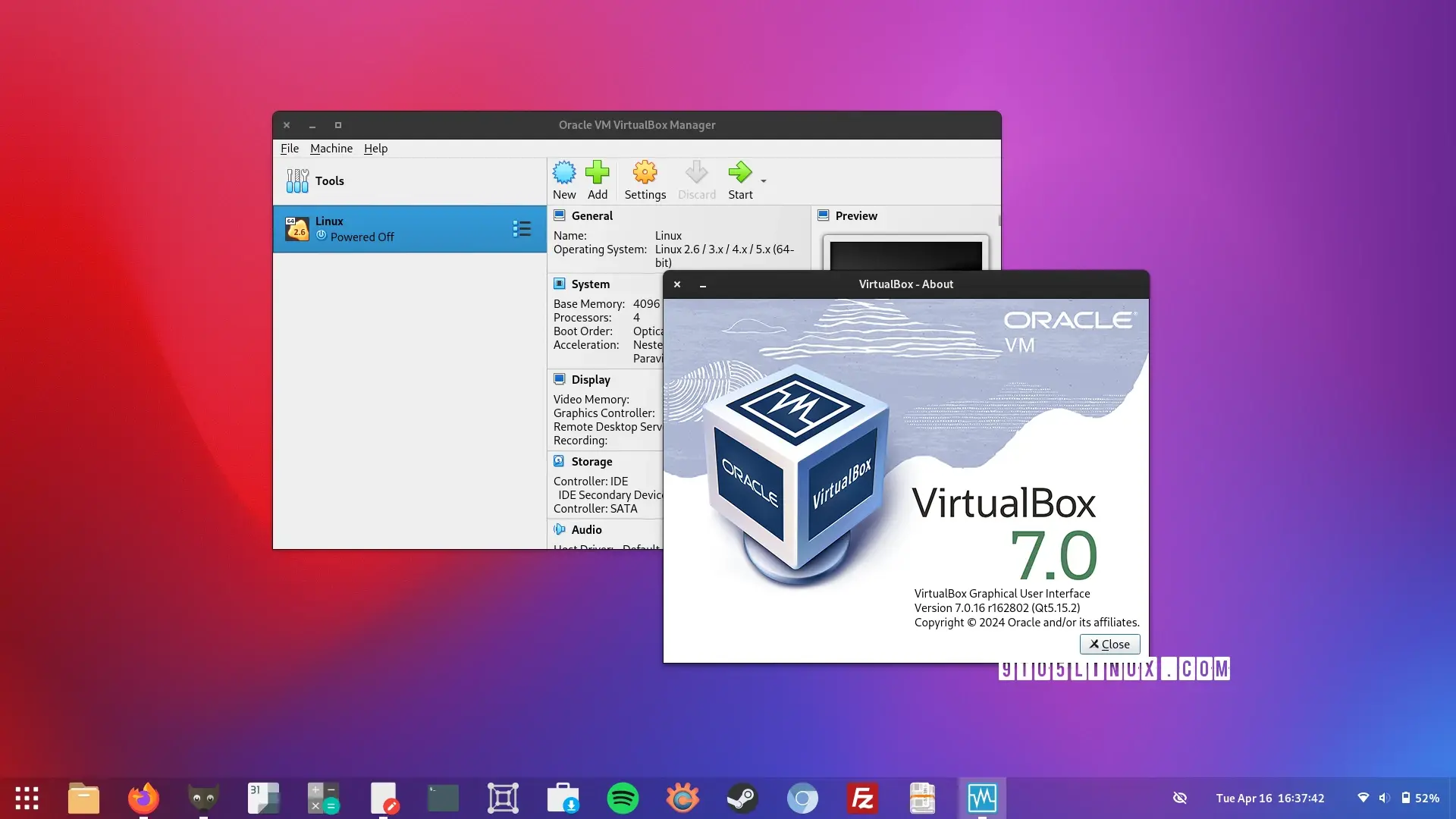I’m genuinely curious, why does VB continue to somehow remain in use, when it’s lacking in features, or behind in usability, in basically every way imaginable? If you’re on a Linux host, you have plenty of 1-click solutions that are incomprehensibly better than this. On Windows, Hyper-V boxes aren’t horribly difficult to get running either, although from my experience, they require the same janky and hacky patches as VB does
Virtual box (for me) is the only app that has always been plug and play when I needed a VM. I’ve had issues with all the other ones. I still can’t figure out how to get GPU passthrough to work on kvm. I tried so much the other day and failed miserably. Gave up and went back to VB.
In boxes there is a toggle that is labeled “3D acceleration” if you flip the toggle your VM will have GPU acceleration.
That’s not GPU passthrough. That just enables VirGL, which is a translation layer that passes some OpenGL calls through to the host’s Mesa installation. It has rather poor performance though, it’s extremely limited and is rather buggy too. You certainly can’t use it for cutting edge gaming.
GPU passthrough is when you pass through an entire GPU device as-is to the virtual machine. That is: if you have an Nvidia RTX 3060, the guest operating system will see an Nvidia RTX 3060 and it can use the native drivers for it. This gives you near-native performance for gaming.
Now, I didn’t even know this was possible with VirtualBox (if so: cool!), but it’s certainly doable with KVM if you have the right motherboard and GPU combination. I have done it, but it is quite the hassle indeed though that isn’t really KVM’s fault.
That’s why it failed for me, I don’t have an Nvidia GPU. I wanted to pass my GPU to my windows install but it never worked and I blamed kvm 🤦🏽♂️ I knew about the first part that the “3rd acceleration” isn’t a full GPU passthrough, but didn’t know the latter was Nvidia only.
It does work with AMD GPUs too, I did it with an RX6800XT myself, but there are some (most…) AMD GPUs that have a reset bug which means they hang if you reboot the guest and you need to powercycle the physical host machine to make the GPU usable for the guest again.
Well that sucks. I have a 580xt GPU. It’s about 7 years old, but still powers. Do you have a link on how to get it working? Pretty please?
To get basic GPU passthrough working, I mainly followed the Arch Linux guide: https://wiki.archlinux.org/title/PCI_passthrough_via_OVMF
Be warned though that this is just the start of the journey. There are all kinds of issues that you need to deal with and decisions that you need to make if you want to practically use it for gaming, and those require lots of googling, piecing bits of information together from all over the place, and trial and error. From memory these are things I had to deal with:
- How to handle storage? Just a qcow2 file or pass through a partition or drive?
- How to handle mouse and keyboard input? Emulated or through a passed through USB port? Both have their pros and cons.
- Audio is a pain in the ass… emulated it either crackly or laggy. There is a way to pass it through to pipewire through a unix socket, but it’s convoluted to setup. Or perhaps you can pass an entire audio device through to your guest?
- Bluetooth audio, for my wireless headset, was an even bigger issue because audio did not get routed correctly to the headset if I just connected to the host. In the end, I got a separate bluetooth dongle for my VM, and passed it through.
- How do you handle the display between guest and host? Two separate monitors? A monitor with dual inputs, and toggle between them? Or something like looking-glass, which sounds appealing but again introduces issues like vrr not working properly, and your GPU will probably need a dummy “dongle” to work without an actual monitor connected.
- Then there’s the CPU and how to divide the cores between guest and host: for best performance, the guest’s cores need to be reserved, and should take into account the CPU topology. For example, I have a 5900x and reserved the 6 cores on one CCX for my VM , leaving the other 6 for my host.
For more information, there’s the /r/VFIO subreddit. Yeah I know, f*** reddit, but it has a lot of useful information. The looking glass site has some FAQs too, even on things not directly related to looking-glass itself. There is some VFIO discussion on the level one forums as well, but they’re not so active.
Anyway if all this sounds like a cool project to spend a few weeks on, I heartily recommend you try it. I sure enjoyed setting this all up and getting it working, but I spent way more time configuring and troubleshooting things than I did gaming with that setup, and in the end I decided that just gaming on Proton and occasionally dual booting for problematic games is a much more practical solution.
I do what your describing (its called vfio) and it works pretty well on Proxmox.
What are the other solutions?
Virt-manager
Does it still need to reboot the guest in order to connect an USB device?
No
Vm manager, gnome boxes
Boxes
Hyper-V is not really better than Virtualbox on Windows. Virtualbox will run anywhere and that is its strength.
On Linux, you should use KVM. I assume that’s what your advocating for.
How share folder host-guest without network access? Last time try need to use samba (did not get working) and then impossible to turn off vm network access. Used qemu for win 10 guest.
VB just install guest addition and disable network interface.
what are those options?
virtualbox is a simple gui i can get working fast whenever i need it to.
Cool beans. KVM is one step away from fully replacing VirtualBox and VMware for desktop virtualisation - getting a Windows 3D driver for Virtio. For use cases that can get away without it, it’s already there.
AFAIK it’s being worked on but time is a major issue for the person handling the MR.
I’d love to donate specifically to get Virtio/VirGL on a Windows guest. Given that VirtualBox and VMware could be on very shaky ground thanks to their owners, I think libvirt will be the long-term solution.
What happened to being able to use VirtualBox as a front-end to KVM? That seemed like the best of both worlds.
It’s still being maintained. It’s a third-party project btw, but it’s just a patchset so you’ll need to build it yourself: https://github.com/cyberus-technology/virtualbox-kvm
Arch users can also install the virtualbox-kvm package from AUR to get it all in one go, nice and easy.
Damn, never knew such thing existed. I’ll definitely give it a try. Thank you.
Why would you do that when libvirt exists and is GTK themed?
I use KDE.
Libvirt is the backend for virtualization. Maybe you meant virtual manager? In that case it is Qt based.
Virtual box is slow and buggy and it probably will always be that way. It is simply the nature of its design.
Quemu+KVM is the way to go.
*virtual manager
Qemu is pretty much an emulator.
Qemu can also be used with KVM, without emulating the entire hardware. My preferred way to virtual machinery.
From linux-kvm.org:
The kernel component of KVM is included in mainline Linux, as of 2.6.20. The userspace component of KVM is included in mainline QEMU, as of 1.3.
Virt-manager uses QEMU and KVM on the backend. The only difference is how you’re managing the VM.
Odd, since in my experience, it’s the most consistently reliable, performant, and easy to setup / use desktop vm package I’ve used. It always seems to “just work” when others don’t
Just work? Maybe. Performance? Not great.
I guess that depends on what we are using it for. I use it for CAD / CAM software that only works in Windows (Vectric Aspire). Nothing else has been able to give me 3d previews with any kind of usable performance.
Virtualbox is not a type I hypervisor. You will get better performance in KVM. Just enable GPU acceleration.
If it is working for great but its lacking many features and isn’t native.
I’ve never been able to get GPU acceleration working in qemu/kvm. That’s also why the “just works” aspect of virtual box is important.
Just… Use virt manager or if you like me hate it’s UI, gnome boxes. They are different UIs for the same thing. And are both infinitely better than virtualbox.
Had to run linux VM at previous job. Dreadful experience. Glad I can run natively now.
I’ve been running my main desktop as a VM since 2009. I make a new VM for every client and plenty of others.
I have no what you are talking about.
You don’t have the same hardware, drivers and software as him. Off course you would not know what he is talking about then.
Hardware was why I went virtual. Before that, for a decade, I ran Linux bare metal, but was spending days recompiling kernels and drivers and futzing around with non-productive activities. Every upgrade would start the cycle again.
Once I went to VMware all those issues went away.
Now that new owners have taken over, it appears that I’m going to have to find a new solution.
I assume you are talking about Virtualbox. Yes, it is slow














